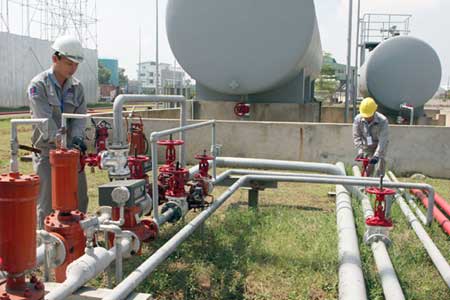 |
Figures from the Ministry of Industry and Trade show that only 166 out of 13,000 fuel stations in Viet Nam sell 5 per cent E5, and only three out of 10 fuel wholesalers have sold the bio-fuel since 2010.
Currently, the country has six factories that produce ethanol, with a capacity of 418,000 tonnes of the product each year.
But more than 80 per cent of the bio-fuel produced is used for export. The bio-fuel consumption rate in the domestic market is under 20 per cent.
Last year, the volume of 5 percent E5 sold domestically was about 22,000 cu.m, equal to only 1.1 per cent of capacity of one of the six factories that produce the fuel.
While fuel stations in only 36 provinces and cities sell bio-fuel, Nguyen Dinh Hiep, head of the Ministry of Industry and Trade's Science and Technology Department, predicts Viet Nam will be using 10-per cent ethanol fuel (E10) nationwide by 2016.
Green planning
With fossil fuel prices going up, the Government has outlined a plan to use bio-fuel.
By next year, the E5 fuel will be sold in HCM City, Ha Noi, Hai Phong, Da Nang, Can Tho, Quang Ngai, and Ba Ria – Vung Tau. The fuel will be sold nationwide one year later.
By 2016, E10 fuel will be sold in pilot cities and provinces and the rest of the country by 2017, Hiep said.
By 2015, the country is expected to have 13 ethanol producing factories, with annual capacity of 1.1 billion litres or 858,000 tonnes.
The ethanol volume is enough to produce 8.5 million tonnes of E10 bio-fuel. Last year, the country's ethanol production was half of the targeted amount.
Nguyen Duyen Cuong, deputy head of the Trade and Market Department of PetroVietnam, said the corporation was building three factories producing bio-fuel in Phu Tho, Quang Ngai and Binh Phuoc provinces.
By 2014 – 15, the three will operate with 100 per cent designed capacity, producing 300,000 cu.m of ethanol every year.
The output is enough to make 6 million cu.m of E5, which would meet 94 per cent of fuel demand nationwide by 2014.
The designed capacity would be able to produce 3 million cu.m of E10, which would meet 40 per cent of the country's fuel demand in 2017, he added.
Cuong said bio-fuel was new in Viet Nam, and the number of fuel stations selling it was still limited. Customers resist buying it, also, he added.
According to PetroVietnam, Brazil's ethanol industry become the second biggest in the world with government supports. The country has 8 million hectares of sugarcane.
Brazil produces 25 billion litres of ethanol annually. More than 80 per cent of vehicles in the country use bio-fuel.
The US government also has programmes to help with the production of ethanol. Special tax rates and financial treatment will be given to involved enterprises, Cuong said.
In Southeast Asia, the Philippines, which produced 149 million litres of bio-diesel and 420 million litres of bio-ethanol last year, offers tax exemptions for ethanol imports from ASEAN- member countries.
Thailand started selling bio-fuel in 2005. Most fuel stations in the country sell E10, which is much cheaper than traditional fuel. Bio-fuel E85 is sold in more than 150 fuel stations in the country.
The E85 fuel has become more and more popular in Thailand, according to Cuong.
Le Anh Tuan, associate professor at Ha Noi University of Technology, who has conducted experiments with ethanol in vehicles, said that E5 and E10 would work well in the engines of existing motorbikes and cars, with no need for any modification.
By My Lê
























